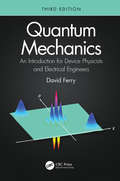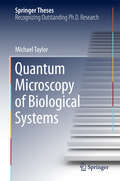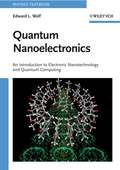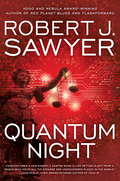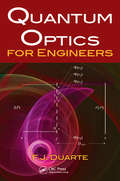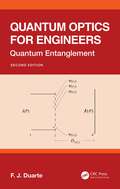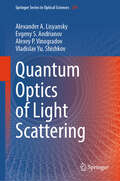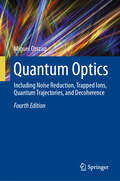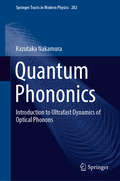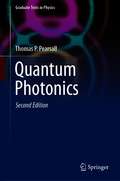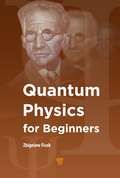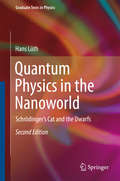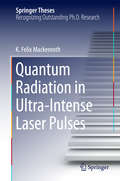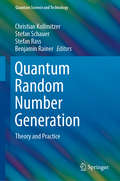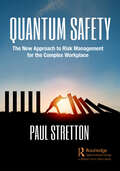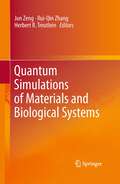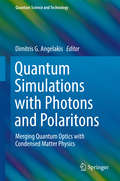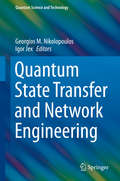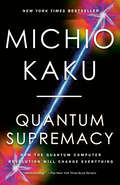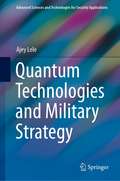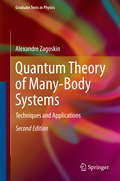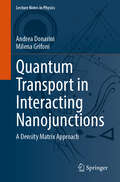- Table View
- List View
Quantum Mechanics: An Introduction for Device Physicists and Electrical Engineers
by David FerryQuantum Mechanics: An Introduction for Device Physicists and Electrical Engineers, Third Edition provides a complete course in quantum mechanics for students of semiconductor device physics and electrical engineering. It provides the necessary background to quantum theory for those starting work on micro- and nanoelectronic structures and is particularly useful for those beginning work with modern semiconductors devices, lasers, and qubits. This book was developed from a course the author has taught for many years with a style and order of presentation of material specifically designed for this audience. It introduces the main concepts of quantum mechanics which are important in everyday solid-state physics and electronics. Each topic includes examples which have been carefully chosen to draw upon relevant experimental research. It also includes problems with solutions to test understanding of theory. Full updated throughout, the third edition contains the latest developments, experiments, and device concepts, in addition to three fully revised chapters on operators and expectations and spin angular momentum, it contains completely new material on superconducting devices and approaches to quantum computing.
Quantum Microscopy of Biological Systems
by Michael TaylorThis thesis reports on the development of the first quantum enhanced microscope and on its applications in biological microscopy. The first quantum particle-tracking microscope, described in detail here, represents a pioneering advance in quantum microscopy, which is shown to be a powerful and relevant technique for future applications in science and medicine. The microscope is used to perform the first quantum-enhanced biological measurements -- a central and long-standing goal in the field of quantum measurement. Sub diffraction-limited quantum imaging is achieved, also for the first time, with a scanning probe imaging configuration allowing 10-nanometer resolution.
Quantum Nanoelectronics: An Introduction to Electronic Nanotechnology and Quantum Computing
by Edward L. WolfA tutorial coverage of electronic technology, starting from the basics of condensed matter and quantum physics. Experienced author Ed Wolf presents established and novel devices like Field Effect and Single Electron Transistors, and leads the reader up to applications in data storage, quantum computing, and energy harvesting. Intended to be self-contained for students with two years of calculus-based college physics, with corresponding fundamental knowledge in mathematics, computing and chemistry.
Quantum Night
by Robert J. SawyerWith such compelling and provocative novels as Red Planet Blues, FlashForward and The WWW Trilogy, Robert J. Sawyer has proven himself to be "a writer of boundless confidence and bold scientific extrapolation" (New York Times). Now, the Hugo and Nebula Award-winning author explores the thin line between good and evil that every human being is capable of crossing...Experimental psychologist Jim Marchuk has developed a flawless technique for identifying the previously undetected psychopaths lurking everywhere in society. But while being cross-examined about his breakthrough in court, Jim is shocked to discover that he has lost his memories of six months of his life from twenty years previously--a dark time during which he himself committed heinous acts.Jim is reunited with Kayla Huron, his forgotten girlfriend from his lost period and now a quantum physicist who has made a stunning discovery about the nature of human consciousness. As a rising tide of violence and hate sweeps across the globe, the psychologist and the physicist combine forces in a race against time to see if they can do the impossible--change human nature--before the entire world descends into darkness. From the Hardcover edition.
Quantum Optics for Engineers
by F.J. DuarteQuantum Optics for Engineers provides a transparent and methodical introduction to quantum optics via the Dirac's bra–ket notation with an emphasis on practical applications and basic aspects of quantum mechanics such as Heisenberg's uncertainty principle and Schrodinger's equation. Self-contained and using mainly first-year calculus and algebra tools, the book: Illustrates the interferometric quantum origin of fundamental optical principles such as diffraction, refraction, and reflection Provides a transparent introduction, via Dirac's notation, to the probability amplitude of quantum entanglement Explains applications of the probability amplitude of quantum entanglement to optical communications, quantum cryptography, quantum teleportation, and quantum computing. Quantum Optics for Engineers is succinct, transparent, and practical, revealing the intriguing world of quantum entanglement via many practical examples. Ample illustrations are used throughout its presentation and the theory is presented in a methodical, detailed approach.
Quantum Optics for Engineers: Quantum Entanglement
by F.J. DuarteThe second edition of Quantum Optics for Engineers: Quantum Entanglement is an updated and extended version of its first edition. New features include a transparent interferometric derivation of the physics for quantum entanglement devoid of mysteries and paradoxes. It also provides a utilitarian matrix version of quantum entanglement apt for engineering applications.Features: Introduces quantum entanglement via the Dirac–Feynman interferometric principle, free of paradoxes. Provides a practical matrix version of quantum entanglement which is highly utilitarian and useful for engineers. Focuses on the physics relevant to quantum entanglement and is coherently and consistently presented via Dirac’s notation. Illustrates the interferometric quantum origin of fundamental optical principles such as diffraction, refraction, and reflection. Emphasizes mathematical transparency and extends on a pragmatic interpretation of quantum mechanics. This book is written for advanced physics and engineering students, practicing engineers, and scientists seeking a workable-practical introduction to quantum optics and quantum entanglement.
Quantum Optics of Light Scattering (Springer Series in Optical Sciences #249)
by Alexey P. Vinogradov Alexander A. Lisyansky Evgeny S. Andrianov Vladislav Yu. ShishkovThis book presents a quantum framework for understanding inelastic light scattering which is consistent with the classical descriptions of Raman phenomena and Rayleigh scattering, thus creating a unified theoretical picture of light scattering. The Raman effect was discovered in 1928 and has since proved to be one of the most powerful tools to study the molecular structure of gases, liquids, and crystals. The subsequent development of new scientific disciplines such as nonlinear optics, quantum optics, plasmonics, metamaterials, and the theory of open quantum systems has changed our views on the nature of Rayleigh and Raman scattering. Today, there are many excellent books on the theory and applications of light scattering, but a consistent description of light scattering from a unified viewpoint is missing. The authors’ approach has the power to re-derive the results of both classical and quantum approaches while also addressing many questions that are scattered acrossthe research literature: Why is Rayleigh scattering coherent while Raman scattering is not, although both phenomena are caused by the incidence of a coherent wave? Why are coherent Stokes and coherent anti-Stokes Raman scattering caused by two coherent incident waves both always coherent? This book answers these questions and more, and explains state-of-the-art experimental results with a first-principles approach that avoids phenomenological arguments. Many of the results presented are appearing in book form for the first time, making this book especially useful for young researchers entering the field. The book reviews basic concepts of quantum mechanics and quantum optics and comes equipped with problems and solutions to develop understanding of the key mathematical techniques. The rigorous approach presented in the book is elegant and readily grasped, and will therefore prove useful to both theorists and experimentalists at the graduate level and above, as well as engineers who useRaman scattering methods in their work.
Quantum Optics: Including Noise Reduction, Trapped Ions, Quantum Trajectories, and Decoherence
by Miguel OrszagThis revised new edition gives a unique and broad coverage of basic laser-related phenomena that allow graduate students, scientists and engineers to carry out research in quantum optics and laser physics. It covers quantization of the electromagnetic field, quantum theory of coherence, atom-field interaction models, resonance fluorescence, quantum theory of damping, laser theory using both the master equation and the Langevin theory, the correlated emission laser, input-output theory with applications to non-linear optics, quantum trajectories, quantum non-demolition measurements and generation of non-classical vibrational states of ions in a Paul trap. This fourth edition provides a new chapter on weak measurement, as well as a new chapter on complementarity. There is also new material included for atom optics and new problems have been added. Each topic is presented in a unified and didactic manner, and is accompanied by specific problems and hints to solutions to deepen the knowledge.
Quantum Optomechanics
by Gerard J. Milburn Warwick P. BowenWritten by leading experimentalist Warwick P. Bowen and prominent theoretician Gerard J. Milburn, Quantum Optomechanics discusses modern developments in this novel field from experimental and theoretical standpoints. The authors share their insight on a range of important topics, including optomechanical cooling and entanglement; quantum limits on
Quantum Phononics: Introduction to Ultrafast Dynamics of Optical Phonons (Springer Tracts in Modern Physics #282)
by Kazutaka NakamuraThis book presents quantum phononics as an exciting new field of research, and introduces readers to the quantum nature of phonons and their application to quantum technologies. Both the theory of and recent experiments in “quantum phononics,” involving e.g. coherent phonons, phonon squeezing, coherent control, and phonon quantum technologies, are presented. The theoretical background of the generation and detection of phonons is described in a way that will be easy to understand for graduate students and experimental scientists who are newcomers to the field. Moreover, the book focuses on coherent phonons produced by ultrafast laser pulses, which can be used for the coherent control of atomic motions in solids and phase transformation. The laser-matter interaction is treated using a density matrix formalism of the time-dependent Schröedinger equation. In addition, the third-order nonlinear optical response of condensed matter is also described.
Quantum Photonics (Graduate Texts in Physics)
by Thomas P. PearsallPhotonics is the discipline of electrons and photons working in tandem to create new physics, new devices and new applications. This textbook employs a pedagogical approach that facilitates access to the fundamentals of quantum photonics. Beginning with a review of the quantum properties of photons and electrons, the book then introduces the concept of their non-locality at the quantum level. It presents a determination of electronic band structure using the pseudopotential method, enabling the student to directly compute the band structures of most group IV, group III-V, and group II-VI semiconductors. The book devotes further in-depth discussion of second quantization of the electromagnetic field that describes spontaneous and stimulated emission of photons, quantum entanglement and introduces the topic of quantum cascade lasers, showing how electrons and photons interact in a quantum environment to create a practical photonic device.This extended second edition includes a detailed description of the link between quantum photon states and the macroscopic electric field. It describes the particle qualities of quantum electrons via their unique operator algebra and distinguishable behavior from photons, and employs these fundamentals to describe the quantum point contact, which is the quantum analogue of a transistor and the basic building block of all nanoscopic circuits, such as electron interferometers.Pearsall’s Quantum Photonics is supported by numerous numerical calculations that can be repeated by the reader, and every chapter features a reference list of state-of-the art research and a set of exercises. This textbook is an essential part of any graduate-level course dealing with the theory of nanophotonic devices or computational physics of solid-state quantum devices based on nanoscopic structures.
Quantum Physics for Beginners
by Zbigniew FicekThe textbook covers the background theory of various effects discussed from first principles, as clearly as possible, to introduce students to the main ideas of quantum physics and to teach the basic mathematical methods and techniques used in the fields of advanced quantum physics, atomic physics, laser physics, nanotechnology, quantum chemistry, and theoretical mathematics. Many of the predictions of quantum physics appear to be contrary to our intuitive perceptions, and the student will learn how it comes about that microscopic objects (particles) behave in unusual ways that are called quantum effects, what we mean by quantum, and where this idea came from. The textbook is supplemented with Problems and Solutions in Quantum Physics, which contains a wide range of tutorial problems from simple confidence builders to fairly challenging problems that provide adequate understanding of the basic concepts of quantum physics.
Quantum Physics in the Nanoworld
by Hans LüthThe book deals with all essential aspects of non-relativistic quantum physics up to the quantization of fields. In contrast to common textbooks of quantum mechanics, modern experiments are described both for the purpose of foundation of the theory and in relation to recent applications. In this respect applications to nano-electronics as well as the realization of quantum-bits are presented and discussed. Furthermore, links are made to other important research fields and applications, such as elementary particle physics, solid state physics and nuclear magnetic resonance tomography in medicine. Even though the representation of the topics is largely performed in terms of Dirac´s bra-ket notation and by use of commutator algebra, the concrete description of the physical basis and the corresponding theoretical concepts are emphasized. Because of little requirement of complex mathematics, the book is suitable as an introduction into quantum physics, not only for physicists but also for chemists, biologists, engineers, computer scientists and even for philosophers as far as they are interested in natural philosophy and epistomology.
Quantum Radiation in Ultra-Intense Laser Pulses
by K. Felix MackenrothScientific advances and several technical breakthroughs have led to a remarkable increase in available laser intensities over the past decades. In available ultra-intense laser fields, photon fluxes may become so high that free charge carriers interact coherently with several of the field's photons. In this thesis such nonlinear interactions are investigated for the prime example of radiation emission by electrons scattered from intense laser pulses of arbitrary temporal structure. To this end, nonlinear quantum field theory is employed taking the interaction with the laser into account exactly. After an in-depth introduction to classical particle dynamics as well as quantum field theory in nonlinearly intense laser fields the emission of one and two photons is explicitly analyzed. The results are then translated to viable technical applications, such as a scheme for the determination of the carrier-envelope phase of ultra-intense laser pulses and a proposal for detecting the strongly suppressed two-photon signal.
Quantum Random Number Generation: Theory and Practice (Quantum Science and Technology)
by Stefan Rass Stefan Schauer Christian Kollmitzer Benjamin RainerThis book provides an overview of state-of-the-art implementations of quantum random number generators (QRNGs), and especially examines their relation to classical statistical randomness models and numerical techniques for computing random numbers. The reader – who ideally has a background in classical statistics, computer science, or cryptography – is introduced to the world of quantum bits step by step, and explicit relations between QRNGs and their classical counterparts are identified along the way. Random number generation is a major pillar of cryptography. Capitalizing on the randomness inherent in quantum phenomena is a rapidly evolving branch of quantum cryptography with countless applications for the future. The value of quantum randomness for cryptographic purposes is empirically demonstrated in statistical evaluations of QRNGs’ performance compared to classical techniques for true and pseudorandom number generation. The book then provides an overview of technical implementations of QRNGs, before a concluding discussion of major achievements and remaining obstacles in the field rounds out the coverage, while also opening the door for future research directions.
Quantum Safety: The New Approach to Risk Management for the Complex Workplace
by Paul StrettonThis book is the most comprehensive review of health and safety in half a century. Most organisational approaches to health and safety are based on the methodology developed during the 1970s, and despite the workplace changing beyond recognition since that time, these approaches have remained untouched. Quantum Safety will develop a new understanding fit for the modern workplace. Quantum Safety is an approach that is part of the "new view" debate. There have been a number of other new approaches to health and safety in recent years, and while they all have merit and improve understanding to help create the optimal, safe working environment, they have failed to significantly create the change desired. These approaches are often flawed at the philosophical or conceptual level or propose a solution without a pathway to implement the principles in safety-critical environments. Quantum Safety: The New Approach to Risk Management for the Complex Workplace is founded on a wholesale critical analysis of the conceptual foundations of health and safety before translating the revised principles into a tangible methodology. Central to the development of Quantum Safety is the application of Complexity Science. The traditional approach to health and safety is considered to be Newtonian – it uses linear models and deterministic analysis. Quantum Safety, due to the full consideration of Complexity Science, introduces multidimensional models and develops analysis based on probabilities. Crucially, this does not render Newtonian methodologies as worthless – in the same manner that Newtonian physics was able to take mankind to the moon, but required the quantum understanding within computers to make it possible – Quantum Safety provides the mechanisms to complete organisations’ safety-based journeys. The new mechanisms are fully developed for the reader at both macro and micro levels. How an organisation measures safety and what it values are reset and re-examined. How we investigate adverse events and the consequential actions taken with employees to develop a true Just Culture within a high-performing culture are also completely revised. Essentially, Quantum Safety creates a pathway for understanding health and safety in the complex modern world. To achieve that, new models are introduced to replace the dated, simple tools and a new language is developed to communicate this powerful approach. It will help propel an organisation from considering safety within a concept of industrialised failure avoidance to valuing safety as an integrated aspect of high performance.
Quantum Simulations of Materials and Biological Systems
by Rui-Qin Zhang Jun Zeng Herbert TreutleinQuantum Simulations of Materials and Biological Systems features contributions from leading world experts in the fields of density functional theory (DFT) and its applications to material and biological systems. The recent developments of correlation functionals, implementations of Time-dependent algorithm into DFTB+ method are presented. The applications of DFT method to large materials and biological systems such as understanding of optical and electronic properties of nanoparticles, X-ray structure refinement of proteins, the catalytic process of enzymes and photochemistry of phytochromes are detailed. In addition, the book reviews the recent developments of methods for protein design and engineering, as well as ligand-based drug design. Some insightful information about the 2011 International Symposium on Computational Sciences is also provided. Quantum Simulations of Materials and Biological Systems is aimed at faculties and researchers in the fields of computational physics, chemistry and biology, as well as at the biotech and pharmaceutical industries.
Quantum Simulations with Photons and Polaritons
by Dimitris G. AngelakisThis book reviews progress towards quantum simulators based on photonic and hybrid light-matter systems, covering theoretical proposals and recent experimental work. Quantum simulators are specially designed quantum computers. Their main aim is to simulate and understand complex and inaccessible quantum many-body phenomena found or predicted in condensed matter physics, materials science and exotic quantum field theories. Applications will include the engineering of smart materials, robust optical or electronic circuits, deciphering quantum chemistry and even the design of drugs. Technological developments in the fields of interfacing light and matter, especially in many-body quantum optics, have motivated recent proposals for quantum simulators based on strongly correlated photons and polaritons generated in hybrid light-matter systems. The latter have complementary strengths to cold atom and ion based simulators and they can probe for example out of equilibrium phenomena in a natural driven-dissipative setting. This book covers some of the most important works in this area reviewing the proposal for Mott transitions and Luttinger liquid physics with light, to simulating interacting relativistic theories, topological insulators and gauge field physics. The stage of the field now is at a point where on top of the numerous theory proposals; experiments are also reported. Connecting to the theory proposals presented in the chapters, the main experimental quantum technology platforms developed from groups worldwide to realize photonic and polaritonic simulators in the laboratory are also discussed. These include coupled microwave resonator arrays in superconducting circuits, semiconductor based polariton systems, and integrated quantum photonic chips. This is the first book dedicated to photonic approaches to quantum simulation, reviewing the fundamentals for the researcher new to the field, and providing a complete reference for the graduate student starting or already undergoing PhD studies in this area.
Quantum State Transfer and Network Engineering
by Georgios M. Nikolopoulos Igor JexFaithful communication is a necessary precondition for large-scale quantum information processing and networking, irrespective of the physical platform. Thus, the problems of quantum-state transfer and quantum-network engineering have attracted enormous interest over the last years, and constitute one of the most active areas of research in quantum information processing. The present volume introduces the reader to fundamental concepts and various aspects of this exciting research area, including links to other related areas and problems. The implementation of state-transfer schemes and the engineering of quantum networks are discussed in the framework of various quantum optical and condensed matter systems, emphasizing the interdisciplinary character of the research area. Each chapter is a review of theoretical or experimental achievements on a particular topic, written by leading scientists in the field. The volume aims at both newcomers as well as experienced researchers.
Quantum Supremacy: How the Quantum Computer Revolution Will Change Everything
by Michio KakuNEW YORK TIMES BESTSELLER • An exhilarating tour of humanity's next great technological achievement—quantum computing—which may supercharge artificial intelligence, solve some of humanity's biggest problems, like global warming, world hunger, and incurable disease, and eventually illuminate the deepest mysteries of science, by the bestselling author of The God Equation. • &“Expertly describes and rectifies common misconceptions about quantum computing." —Science "[Kaku's] lucid prose and thought process make abundant sense of this technological turning point.&” —The New York Times Book ReviewThe runaway success of the microchip may finally be reaching its end. As shrinking transistors approach the size of atoms, the phenomenal growth of computational power inevitably collapses. But this change heralds the birth of a revolutionary new type of computer, one that calculates on atoms themselves.Quantum computers promise unprecedented gains in computing power, enabling advancements that could overturn every aspect of our daily lives. While the media has mainly focused on their startling potential to crack any known encryption method, the race is already on to exploit their incredible power to revolutionize industry. Automotive makers, medical researchers, and consulting firms are all betting on quantum computing to design more efficient vehicles, create life-saving new drugs, and streamline businesses. But this is only the beginning. Quantum computing could be used to decode the complex chemical processes needed to produce cheap fertilizers and unleash a second Green Revolution; create a super battery that will enable the Solar Age; or design nuclear fusion reactors to generate clean, safe, renewable energy. It may even unravel the fiendishly difficult protein folding that lies at the heart of as-yet-incurable diseases like Alzheimer&’s, ALS, and Parkinson&’s. Already, quantum computers are being put to work to help solve the greatest mystery in science—the origin of the universe.There is no single problem humanity faces that might not be addressed by quantum computers. With his signature clarity and enthusiasm, Dr. Michio Kaku, who has spent his entire professional life working on the quantum theory, tells the thrilling story of this exciting scientific frontier and the race to claim humanity&’s future.
Quantum Technologies and Military Strategy (Advanced Sciences and Technologies for Security Applications)
by Ajey LeleThis book is about the strategic relevance of quantum technologies. It debates the military-specific aspects of this technology. Various chapters of this book cohere around two specific themes. The first theme discusses the global pattern of ongoing civilian and military research on quantum computers, quantum cryptography, quantum communications and quantum internet. The second theme explicitly identifies the relevance of these technologies in the military domain and the possible nature of quantum technology-based weapons. This thread further debates on quantum (arms) race at a global level in general, and in the context of the USA and China, in particular. The book argues that the defence utility of these technologies is increasingly becoming obvious and is likely to change the nature of warfare in the future.
Quantum Theory and Fuzzy Systems: Quantum and Fuzzy Approaches to Social Network Analysis and Group Decisions (Studies in Computational Intelligence #1186)
by Tofigh Allahviranloo Sovan SamantaThis book dives into the fascinating intersection of quantum theory and fuzzy systems. This work is inspired by quantum theory and its real-world applications. It bridges the gap between abstract theoretical concepts and practical implementations in quantum theory-based group decision-making and graph theory/social networks. Highlights: Core concepts: Begin with uncertainty in quantum theory and fuzzy systems and familiarise yourself with the basics of quantum graphs. Real-World Applications: Explore methods for multi-attribute group decision-making, choosing green building materials, and evaluating wearable health devices, renewable energy options, and cell phones using quantum decision methods. Advanced Exploration: Investigate dynamic centrality measures for brain networks, routing protocols, centrality metrics, link prediction, and applications of quantum graphs. Comprehensive topics: Learn about green supplier selection, investment decisions under uncertainty, sustainable solar energy management, and more. Innovative approaches: Examine topological indices, dominance theory, applications of quantum computing, social fuzzy and quantum networks, scenarios of co-concurrence, and optimization techniques in quantum graphs. This comprehensive guide is an indispensable resource for students, researchers, and professionals who want to explore the applications of quantum theory in network science, quantum computing, and decision-making. Whether readers are experts or novices, this book provides knowledge and practical insights to navigate the complexity of uncertainty in our networked world.
Quantum Theory of Many-Body Systems
by Alexandre ZagoskinThis text presents a self-contained treatment of the physics of many-body systems from the point of view of condensed matter. The approach, quite traditionally, uses the mathematical formalism of quasiparticles and Green's functions. In particular, it covers all the important diagram techniques for normal and superconducting systems, including the zero-temperature perturbation theory and the Matsubara, Keldysh and Nambu-Gor'kov formalism, as well as an introduction to Feynman path integrals. This new edition contains an introduction to the methods of theory of one-dimensional systems (bosonization and conformal field theory) and their applications to many-body problems. Intended for graduate students in physics and related fields, the aim is not to be exhaustive, but to present enough detail to enable the student to follow the current research literature, or to apply the techniques to new problems. Many of the examples are drawn from mesoscopic physics, which deals with systems small enough that quantum coherence is maintained throughout their volume and which therefore provides an ideal testing ground for many-body theories.
Quantum Transport in Interacting Nanojunctions: A Density Matrix Approach (Lecture Notes in Physics #1024)
by Andrea Donarini Milena GrifoniThis book serves as an introduction to the growing field of quantum many-body transport in interacting nanojunctions. It delves into a theoretical approach based on a general density-matrix formulation for open quantum systems. In the book, relevant transport observables, like the current or its higher order cumulants, are obtained by evaluating quantum statistical averages. This approach requires the knowledge of the reduced density matrix of the interacting nanosystems. The formulation for addressing transport problems, based on the evolution of the reduced density operator in Liouville space, is highly versatile. It enables the treatment of charge and spin transport across various realistic nanostructures. Topics encompass standard Coulomb blockade, cotunneling phenomena in quantum dots, vibrational and Franck-Condon effects in molecular junctions, as well as many-body interference observed in double quantum dots or carbon nanotubes. Derived from lectures tailored for graduate and advanced students at the University of Regensburg in Germany, this book is enriched with exercises and step-by-step derivations.
Quantum Transport: Atom to Transistor
by Supriyo DattaThis 2005 book presents a unique approach to the fundamentals of quantum transport, and is aimed at senior undergraduate and graduate students. Some of the most advanced concepts of non-equilibrium statistical mechanics are included and yet no prior acquaintance with quantum mechanics is assumed. Chapter 1 provides a description of quantum transport in elementary terms accessible to a beginner. The book then works its way from the hydrogen atom to nanostructures ending with a unified model for quantum transport along with illustrative examples showing how conductors evolve from the atomic to the ohmic regime (or from 'atom to transistor') as they get larger. Many numerical examples are used to provide concrete illustrations and the corresponding MATLAB codes are provided in the book. These codes, along with videostreamed lectures by the author, keyed to specific sections of the book, are available at the webpage for the book - under 'resources and solutions'.
